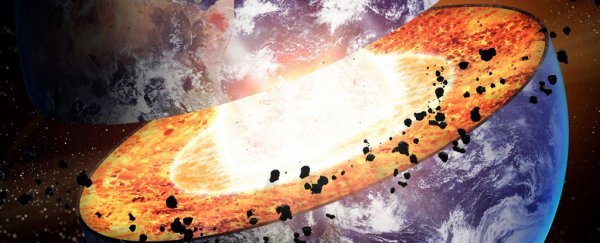Scientists have a new explanation for why Earth's inner core remains solid - despite being hotter than the surface of the Sun. Turns out, it could be all down to the atomic architecture of the crystallised iron ball at Earth's centre.
Researchers suggest that this iron core exists in a never-before-seen atomic state that allows it to withstand the incredible temperatures and pressures found in the centre of our planet – and if they're right, it could solve a mystery that's puzzled scientists for decades.
A team from the KTH Royal Institute of Technology in Sweden used Triolith – one of the country's largest supercomputers – to simulate what atomic processes might be happening some 6,400 kilometres (4,000 miles) beneath our feet.
As with any metal, the atomic-scale structures in iron change depending on temperature and pressure. At room temperature and under normal pressure, iron is in what's called a body-centered cubic (BCC) phase; under high pressure, it switches to a hexagonal close packed (HCP) phase.
These technical terms describe the arrangement of atoms inside the metal, which in turn affects its strength and other properties, such as whether it stays solid or not.
Until now, it was thought the solid, crystallised iron at Earth's core was in an HCP arrangement, because conditions were just too unstable for BCC.
The new research turns that on its head, suggesting that the environment at the centre of the planet actually strengthens this BCC arrangement, rather than breaking it up.
"Under conditions in Earth's core, BCC iron exhibits a pattern of atomic diffusion never before observed," says one of the researchers, Anatoly Belonoshko.
"The BCC phase goes by the motto: 'What does not kill me makes me stronger.' The instability kills the BCC phase at low temperature, but makes the BCC phase stable at high temperature."
Belonoshko likens the extreme atomic activity of the iron at the centre of Earth to cards being shuffled in a deck – while the atoms might be getting shuffled incredibly rapidly due to the high forces of temperature and pressure, the deck remains intact.
And those forces really are remarkable: 3.5 million times the pressure we experience at the surface, along with temperatures some 6,000°C (10,800°F) hotter than those we experience at the surface.
The data crunched by Triolith also shows that 96 percent of Earth's inner core is likely to be made up of iron – a higher figure than previous estimates, with nickel and other light elements making up the rest.
Another mystery that could be solved by the latest research is why seismic waves travel faster between the poles than through the equator – a feature technically known as anisotropy – which means something organised in one particular direction, like grains in wood.
The researchers say the behaviour of BCC iron under the intense conditions at Earth's core could be enough to create large-scale anisotropic effects, opening up another avenue for scientists to explore in the future.
It's important to note that these hypotheses are based on specific simulations of Earth's internal movements, and separate teams running different models based on different calculations could end up with results that are incompatible with these conclusions.
Until we can figure out how to get actual instruments down there, we'll never be 100 percent sure that the calculations are correct - and with the kinds of pressures and temperatures that are thought to exist down there, we might never have direct evidence of the core's activity.
But it's important research to pursue, despite the challenges, because once we know more about the inner workings of Earth, we can make better predictions about what will happen next.
"The ultimate goal of earth sciences is to understand the past, present and future of the Earth," says Belonoshko, "and our prediction allows us to do just that."
The findings are published in Nature Geoscience.
